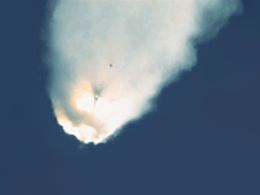SpaceX CRS-7

Disintegration of the SpaceX CRS-7 launch vehicle approximately two minutes after liftoff as seen from a NASA tracking camera.
|
|
| Mission type | ISS resupply |
|---|---|
| Operator | NASA |
| Mission duration | 2 minutes 19 seconds (1 month planned) |
| Spacecraft properties | |
| Spacecraft type | Dragon |
| Manufacturer | SpaceX |
| Start of mission | |
| Launch date | 14:21:11, June 28, 2015 |
| Rocket | Falcon 9 v1.1 |
| Launch site | Cape Canaveral SLC-40 |
| Contractor | SpaceX |
| End of mission | |
| Disposal | Destroyed on launch |
| Destroyed | 14:23:30, June 28, 2015 |
| Orbital parameters | |
| Reference system | Geocentric |
| Regime | Low Earth |
| Inclination | 51.6 degrees |
| Epoch | Planned |
| Berthing at ISS | |
| Berthing port | Harmony nadir |
|
|
|
SpaceX CRS-7, also known as SpX-7, was a private American rocket cargo resupply mission to the International Space Station, contracted to NASA, which launched and failed on June 28, 2015. It disintegrated 139 seconds into the flight after launch from Cape Canaveral, just before the first stage was to separate from the second stage. It was the ninth flight for SpaceX's uncrewed Dragon cargo spacecraft and the seventh SpaceX operational mission contracted to NASA under a Commercial Resupply Services contract. The vehicle launched on a Falcon 9 v1.1 launch vehicle. It was the nineteenth overall flight for the Falcon 9 and the fourteenth flight for the substantially upgraded Falcon 9 v1.1.
In January 2015, the launch was tentatively scheduled by NASA for no earlier than June 13, 2015. This was adjusted to June 22, 2015, then moved forward to June 19, 2015 and adjusted again to June 26, 2015. Subsequently, the launch had been rescheduled to June 28, 2015 at 14:21:11 UTC, from Cape Canaveral LC-40. The launch was scheduled to be the third controlled-descent and landing test for the Falcon 9's first stage. It would have attempted to land on a new autonomous drone ship named Of Course I Still Love You – named after a ship in the novel The Player of Games by Iain M. Banks. The spacecraft was planned to stay in orbit for five weeks before returning to Earth with approximately 1,400 pounds (640 kg) of supplies and waste.
...
Wikipedia

